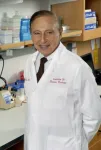(Press-News.org) The recent public health emergency declarations in New York and London due to polio infections and detection of the virus in these cities’ wastewater strongly indicate that polio is no longer close to being eradicated.
Now, four members of the Global Virus Network (GVN) proposed changes in global polio eradication strategy to get the world back on track to one day eliminating polio’s threat. Authors of the recommendations included University of Maryland School of Medicine Institute of Human Virology’s Director and Co-Founder Robert C. Gallo, MD, The Homer & Martha Gudelsky Distinguished Professor in Medicine, and Co-Founder and Chair of the Scientific Leadership Board of GVN; two of the world’s most prominent poliovirus experts, Konstantin Chumakov, PhD, DSci, Adjunct Professor at the George Washington University and the University of Maryland, and Stanley Plotkin, MD, Scientific Advisor of the Coalition for Epidemic Preparedness Innovations (CEPI); and GVN’s President Christian Bréchot, MD, PhD, Professor of University of South Florida.
They suggested that eradication is possible only through ensuring the highest possible vaccination coverage worldwide and maintaining it indefinitely. Vaccination policies must be tailored individually for different regions of the world and use both the polio vaccine made of inactivated virus (in combination with other vaccines), as well as improved novel oral polio vaccines that use live, weakened virus. The experts also urged reconvening a scientific group advising the World Health Organization on poliovirus eradication that can respond as needed and adapt policies in the face of newer data or public health emergencies.
The infectious disease experts published their views in a perspective in the New England Journal of Medicine on February 16, 2023.
The Global Polio Eradication Initiative (GPEI), which formed 34 years ago, aimed for a goal of polio eradication by 2000. This group developed the original polio eradication plan and formed a scientific advisory group, which was later disbanded before the projected goals were reached. According to the authors, this led to some decisions that were not based of solid science, including no longer immunizing against one of the three kinds of poliovirus while a weaker version of this poliovirus was still present in communities. The resulting resurgence of poliovirus circulation continues until this day, and the virus reappeared in the U.K., U.S., and other countries after decades when it thought to be eradicated.
“The Initiative based their guidelines on the strategy that was used to eradicate smallpox. However, poliovirus is trickier in that for every person paralyzed by infection, hundreds have no symptoms at all, meaning the virus can silently circulate in communities without anyone knowing it,” said Dr. Gallo. “It was premature to assume that plans would run their course smoothly. These recent outbreaks confirm the need for an active scientific advisory group that can council, mobilize, and adjust the polio eradication plan in real-time as needed.”
Over the last few decades, there has been an increase in global travel, which can allow infections to migrate from developing nations where they are more common to communities in industrialized nations where they can spread undetected becoming the greatest danger to the unvaccinated and people with weakened immune systems.
With most people in the U.K. and the U.S. vaccinated against polio, how did this recent outbreak in two major international cities happen? As with other viruses once thought rare in more developed countries, such as measles or mumps, some communities chose not to vaccinate. Also, the nature of the polio vaccines in industrialized nations may have allowed asymptomatic infections to circulate undetected for a while now.
There are two main types of polio vaccines: the injectable version uses noninfectious virus particles to generate immunity (IPV) or the oral polio vaccine (OPV) that uses a live, weakened version of the virus.
“The injectable ‘killed' polio vaccine protects from paralysis, but unlike the live version it does not generate robust immunity in the intestinal tract needed to prevent virus circulation. This means that asymptomatic cases can circulate in vaccinated individuals. So then, why do we use not the live version instead?” said Dr. Chumakov. “The live, attenuated version can revert to virulence (a more an infectious version) and spread to people who are unvaccinated or who have compromised immune systems and occasionally cause paralytic disease. In fact, mutated versions of the oral polio vaccine are what are currently circulating in London and New York. It’s a Catch-22, but there may be a way out: recently a new version of the vaccine was developed that does not convert to virulent vaccine-derived poliovirus. In combination with the injectable polio vaccine, this novel oral polio vaccine can become an effective tool to safely create comprehensive immunity that can stop the spread of the disease.”
The current polio eradication planned for phasing out the live, oral polio vaccines three years after the last wild or natural poliovirus case is documented, replacing it with the injectable polio vaccine.
“As history has recently shown us with COVID vaccines, just because we would like these vaccines to be available, it does not mean they will be. There may be a scramble and the richer countries will secure vaccines before the others,” said Dr. Plotkin. “Therefore, we at the GVN propose that the group institute a policy change not based solely on milestones, but rather whether there is an appropriate supply to compensate for the increased demand. Better yet, incorporate a strategy for ensuring there will be available injectable polio vaccines to support the world supply when the time comes.”
Once the world converts entirely to injectable vaccines, the GEPI’s plan was to remove all polio vaccines ten years after this transition.
“The biggest problem in the way of polio eradication is to do it safely through the combined use of inactivated and live oral vaccines. The former would prevent paralysis from both wild and vaccine-derived poliovirus, whereas the latter would eventually prevent circulation of both forms of poliovirus and paralysis,” said Dr. Bréchot. “The vaccine industry is capable of making both if they are given the order to do so.”
About the Institute of Human Virology
Formed in 1996 as a partnership between the State of Maryland, the City of Baltimore, the University System of Maryland, and the University of Maryland Medical System, the IHV is an institute of the University of Maryland School of Medicine and is home to some of the most globally recognized and world-renowned experts in all of virology. The IHV combines the disciplines of basic research, epidemiology, and clinical research in a concerted effort to speed the discovery of diagnostics and therapeutics for a wide variety of chronic and deadly viral and immune disorders, most notably HIV, the virus that causes AIDS. For more information, visit ihv.org and follow us on Twitter @IHVmaryland.
About the Global Virus Network (GVN)
The Global Virus Network (GVN) is essential and critical in the preparedness, defense, and first research response to emerging, exiting, and unidentified viruses that pose a clear and present threat to public health, working in close coordination with established national and international institutions. It is a coalition comprised of eminent human and animal virologists from 71 Centers of Excellence and 9 Affiliates in 40 countries worldwide, working collaboratively to train the next generation, advance knowledge about how to identify and diagnose pandemic viruses, mitigate and control how such viruses spread and make us sick, as well as develop drugs, vaccines, and treatments to combat them. No single institution in the world has expertise in all viral areas other than the GVN, which brings together the finest medical virologists to leverage their individual expertise and coalesce global teams of specialists on the scientific challenges, issues, and problems posed by pandemic viruses. The GVN is a non-profit 501(c)(3) organization. For more information, please visit https://gvn.org/. Follow us on Twitter at @GlobalVirusNews
END
Eradicating polio will require changing the current public health strategy
University of Maryland School of Medicine Institute of Human Virology’s Robert Gallo says policy decisions should reflect the science
2023-03-06
ELSE PRESS RELEASES FROM THIS DATE:
Southwest Research Institute develops device to test friction, wear associated with EV fluids
2023-03-06
SAN ANTONIO — March 6, 2023 —A Southwest Research Institute team has developed a mechanical testing device to analyze fluids and lubricants formulated for electric vehicles. The team modified a commercial tribology testing device to give it the capability to evaluate the impact of electric currents in fluids, measuring the wear and friction on the automobile parts in the presence of an applied voltage.
“The electrification of the automotive industry has accelerated over recent years, ...
Can certain nutrients protect against the effects of fetal alcohol exposure?
2023-03-06
Fetal alcohol exposure at any stage of pregnancy can lead to congenital malformations, as well as cognitive, behavioral, and emotional impairments in offspring. New research conducted in mice and published in The FASEB Journal indicates that even very early embryos exposed to alcohol can experience growth restriction, brain abnormalities, and skeletal delays, but feeding pregnant mothers certain nutrients prior to conception and throughout pregnancy can reduce the incidence and severity of the alcohol-induced defects.
The beneficial effects were seen with a combination of four nutrients—folic acid, choline, betaine, and vitamin B12.
The authors stress that the ...
Diversity training for police officers: one-and-done efforts aren't enough
2023-03-06
What explains persistent racial disparities in policing, despite police departments’ repeated investments in bias-training programs? A wide range of data indicate that police in the United States tend to stop, arrest, injure, or kill more Black people than White people. Calvin K. Lai (Washington University in St. Louis) and Jaclyn A. Lisnek (University of Virginia) analyzed the effectiveness of a day-long implicit-bias-oriented diversity training session designed to increase U.S. police officers’ knowledge of bias, concerns about bias, and use of evidence-based strategies to mitigate bias. Their ...
As naloxone treatment becomes more widespread heroin use is not on the rise among adolescents
2023-03-06
March 6, 2023-- The adoption of laws around naloxone use is not associated with changes in adolescent lifetime heroin or injection drug use (IDU), finds a new study at Columbia University Mailman School of Public Health. According to latest results, naloxone access and pharmacy naloxone distribution were more consistently associated with decreases rather than increases in lifetime heroin and IDU among adolescents. While some critics contend that naloxone expansion may inadvertently promote high-risk substance use behaviors among adolescents, until now this question had not been directly investigated. The ...
Small changes in the kitchen can lead to big impact on your family’s health
2023-03-06
DALLAS, March 6, 2023 — What people eat and drink affects heart and brain health and is essential for managing health conditions like blood pressure, diabetes and high cholesterol. Hispanic adults are at higher risk for Type 2 diabetes and have some of the highest prevalence of poorly controlled blood pressure,[1] two major risk factors for heart disease.[2] As a champion for health equity, today the American Heart Association, the leading global voluntary health organization dedicated to fighting heart disease and stroke for all, launched ‘Together at the Table/ Juntos En La Mesa.’
The campaign is designed to inspire ...
Roy and Diana Vagelos Institute for Biomedical Research Education launched at Columbia University with $175 million gift
2023-03-06
NEW YORK, March 6, 2023—With the COVID-19 pandemic highlighting the critical importance of biomedical research and new questions being raised about society’s capacity to generate world-changing scientific breakthroughs,1, Roy and Diana Vagelos have made a $175 million gift to Columbia University to address this need. The Vagelos Institute for Biomedical Research Education created with this gift will be home to PhD students pursuing the most creative, potentially disruptive ideas in biomedical science, and will spur the training of more physician-scientists able ...
Being sleepless in Seattle – or anywhere – may spell trouble for your heart
2023-03-06
DALLAS, March 6, 2023 — Scientific researchers have noticed a marked increase in heart attacks and strokes in the days following the change to daylight saving time each spring. However, the American Heart Association, the leading global health organization dedications to fighting heart disease and stroke, says losing sleep anytime can be a major risk factor for cardiovascular disease.
“Getting a good night’s sleep every night is vital to cardiovascular health. Adults should aim for an average of 7-9 hours, and babies and kids ...
This starchy bioplastic could make soggy paper straws a thing of the past
2023-03-06
In the fight against pollution, several regions in the U.S. have banned the use of plastic straws. Alternative materials exist, but most options are either too expensive to scale up, go limp in drinks or taste bad. But now, a team reporting in ACS Omega has developed a new type of bioplastic film from all-natural, degradable materials that can be rolled into a straw that doesn’t get soggy and is stronger than plastic.
As efforts to reduce plastic waste take hold, many researchers and companies have turned to plastic alternatives to fabricate straws that comply with new laws and regulations. But so far, most options either end up breaking ...
Octapharma USA research at AAAAI: cutaquig® study at higher infusion rates presented
2023-03-06
PARAMUS, N.J. (March 6, 2023) – Octapharma USA presented research at the American Academy of Allergy, Asthma & Immunology (AAAAI) Annual Meeting evaluating the efficacy and safety of cutaquig® (Immune Globulin Subcutaneous [Human]-hipp, 16.5% solution) infusions at higher infusion parameters, potentially offering greater dosing flexibility for patients.
Subcutaneous immunoglobulin (SCIG) has been an accepted mode of infusion for over 30 years and, with its increased utilization, improvements in methodology now drive replacement therapy in patients with primary immune deficiency. To further explore dosing flexibility with potential reductions ...
Erratic sleep patterns linked to elevated blood pressure in teens with extra belly weight
2023-03-06
Research Highlights:
A new study found that the link between excess weight and higher blood pressure in adolescents was stronger among those who also had irregular sleep patterns.
Irregular sleep patterns contributed to elevated blood pressure in teens who had more visceral fat (excess weight in the belly/abdominal area).
The researchers suggest that school schedules and extracurricular responsibilities often clash with teens’ natural tendency to go to bed later and sleep later, which may lead to irregular timing of sleep and a cascade of consequences for heart health later in life.
Embargoed until 4 a.m. CT/5 a.m. ET Monday, March 6, 2023
DALLAS, March ...
LAST 30 PRESS RELEASES:
University of Oklahoma researcher awarded funding to pursue AI-powered material design
Exploring how the visual system recovers following injury
Support for parents with infants at pediatric check-ups leads to better reading and math skills in elementary school
Kids’ behavioral health is a growing share of family health costs
Day & night: Cancer disrupts the brain’s natural rhythm
COVID-19 vaccination significantly reduces risk to pregnant women and baby
The role of vaccination in maternal and perinatal outcomes associated with COVID-19 in pregnancy
Mayo Clinic smartwatch system helps parents shorten and defuse children's severe tantrums early
Behavioral health spending spikes to 40% of all children’s health expenditures, nearly doubling in a decade
Digital cognitive behavioral treatment for generalized anxiety disorder
Expenditures for pediatric behavioral health care over time and estimated family financial burden
Air conditioning in nursing homes and mortality during extreme heat
The Alps to lose a record number of glaciers in the next decade
What makes a good proton conductor?
New science reporting guide published for journalists in Bulgaria
New international study reveals major survival gaps among children with cancer
New science reporting guide published for journalists in Turkey
Scientists develop a smarter mRNA therapy that knows which cells to target
Neuroanatomy-informed brain–machine hybrid intelligence for robust acoustic target detection
Eight SwRI hydrogen projects funded by ENERGYWERX
The Lundquist Institute and its start-up company Vitalex Biosciences Announces Strategic Advancement of Second-Generation fungal Vaccine VXV-01 through Phase 1 Trials under $40 Million Competitive Con
Fine particles in pollution are associated with early signs of autoimmune disease
Review article | Towards a Global Ground-Based Earth Observatory (GGBEO): Leveraging existing systems and networks
Penn and UMich create world’s smallest programmable, autonomous robots
Cleveland researchers launch first major study to address ‘hidden performance killer’ in athletes
To connect across politics, try saying what you oppose
Modulating key interaction prevents virus from entering cells
Project explores barriers to NHS career progression facing international medical graduates
Jeonbuk National University researchers explore the impact of different seasonings on the flavor perception of Doenjang soup
Two Keck Medicine of USC Hospitals named Leapfrog Top Teaching Hospitals
[Press-News.org] Eradicating polio will require changing the current public health strategyUniversity of Maryland School of Medicine Institute of Human Virology’s Robert Gallo says policy decisions should reflect the science




